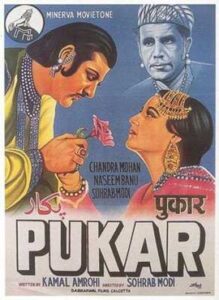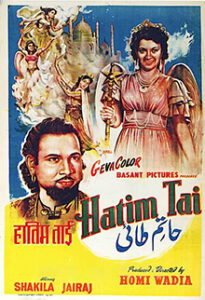1954 Delhi, India
Sharda Malhotra
Born 1944
Delhi, India
Interviewed on 16th February 2021
By Saumya Malhotra
[i]I think I remember what it was called: Pukar (1939). This would’ve been in 1953, maybe

1954…I must have been a little girl, ten or eleven years old. I know now that it first came out in 1939, so we must have caught a re-release, but it was the first one I ever saw. They would put up old pictures again and again back then because there were so few films being made in India at the time. This one had sound—the silent ones were before my time—but it was still black-and-white.
You know, up until then, I really didn’t know what a movie was in the first place. And that was the first time I found out! I remember the big, red curtains parting, and then lights, and sounds, and people running, or walking about, singing songs…I remember nothing of the story or the hero and heroine, but what really registered and stood out then was the movement: People, on a wall, moving. That was new. That was amazing.
We used to go to a “cinema house”—that’s what we called them back then—close to our home: Palace Cinema Hall[ii], in Azad Market, Pul Bangash, Delhi 6[iii]—a huge building with movie posters plastered all over it. And when I say it was close by, I mean it was a thirty-minute walk or taanga (horse-drawn carriage) ride, and going to the movies was a once-in-a-year, summertime affair. I spent most of my childhood in that neighborhood, but I went back after sixty years in 2018. The Palace Cinema Hall seemed so grand back then—on the outside—but it is rather dilapidated now.

How did we get to know about new releases? Well, that’s actually the funniest story of them all. You won’t believe it, but there were processions that traveled from neighborhood to neighborhood; there was always a man wearing a large cardboard cube on his head, the movie poster displayed on its front, and there were always men with loud drums accompanying him. They’d travel by foot, or rickshaw, and though I’m sure there were newspaper advertisements too, the processions are how we heard about the movies.
Anyway, it cost five annas[iv] for a ticket back then, and because we’d just migrated from then-Pakistan during the Partition, that was almost too expensive! So on a summer day when my father and my two elder brothers had gone off to work, and my mother was just about to give in to her famous predilection for afternoon naps, my three sisters and I would negotiate with our mother to finish our chores and homework early in exchange for permission to go to the movies. When she gave in, we were off and afoot!
I really cherish those memories of us four as young sisters, walking through that busy market, passing by bailgaadis (bullock carts), buses, rickshaws, bicycles—I don’t think there were very many scooters or bikes there yet—, and all sorts of little roadside shops with mochis (shoe repairer-and-shiners), odd-job-workers and men selling motor parts. Then we’d get to the Palace Cinema Hall, stand in line, hand over the coins to buy our matinée tickets and enter the theater, where an usher would tell us which seat numbers we were assigned.
Even back then, I think the Palace Cinema Hall was really only a “palace” by size: There was no grandeur to the interiors, just rows of tiny chairs, with the slightest cushioning, and a big, fluorescent “Exit” sign at the back. There were ceiling fans, but no air conditioning—understandably, because “AC” was unheard of in India at the time—, and a distinctly unpleasant, leathery smell about the place, the kind you’d expect in Delhi’s sweltering heat.
There was no canteen and no concessions offered inside—nobody knew what popcorn was—but the movies were very long, and each one had an “interval,” or intermission. That’s when we’d run out to get whatever street food was outside—piping hot chhole (chickpea curry), baraf ka gola (flavored ice-balls), pani puri…but the real delight, and at least half the excitement of the day, was the kulfi (traditional Indian ice-cream on a stick): It was creamy; it was plainly flavored; it had no frills but it was delicious.
So for the longest time, the movie-going experience was a rare novelty, and just a ton of family fun and happiness. We didn’t have too much money to spend growing up, but we always enjoyed the movies—as entertainment. I don’t think we were ever concerned with directors or acting chops or producers until much, much later. It was the entertainment that pulled us in: I remember Hatim Tai (1956), for example, which was all about adventure, fantasy, swords, stunts and special effects, and which still stands out like that.


Now, the first story I really remember is that of a movie called Sangam (1964)[v]. This was a big-budget production from the Kapoors, Bollywood’s “first family” of celebrated actors, directors and producers. It featured superstar lead actors, the dashing Raj Kapoor as an Indian Air Force Man and the beautiful Vaijayanthimala as someone else’s betrothed. As a teenaged girl, the dramatic love-triangle story shot in enchanting foreign locations, complete with romantic song and dance, was hugely appealing—despite its 4-hour-long run time. It was also the first “color film” I ever saw. And the hero-saves-the-girl narrative truly won me over.
I didn’t fully understand how film worked until we sisters—then teenagers—visited a well-off aunt in Ludhiana, Punjab, India. She and her husband took us to a movie theater that had balconies or tiny cabins, like in opera halls today, just enough for five or six people. The special treatment really elevated the experience, and we even got served food and Coca Cola inside! Then the ushers took us “behind the scenes,” and I vividly remember watching an actual film reel spinning. A few years later, I joined the National Cadet Corps[vi] for a couple of years. The camp was in a village close to Delhi, and one evening, we sat down on the floor to watch a movie. Before then, I had thought there was something from “behind” the screen, like a box, that would throw out characters and scenes to produce a movie. But now I saw that we could project a film onto a big white cloth and simply watch it like that!
It was just the best.
[i] Interview responses translated from Hindi to English, and edited for clarity.
[ii] Palace Cinema Hall was Asia’s largest seater (with a seating capacity of 800 people) when it was built in the 1940s. It was also the first to get a movie screening license under the newly-independent Republic of India in 1948. It has been closed as disputed property for the past decade. Source: https://studio.camp/projects/motornama/.
[iii] Alternative term for “Old Delhi,” founded by Mughal Emperor Shah Jahan c. 1639. This area is now part of the broader National Capital Region of Delhi, India, just outside the capital city of New Delhi.
[iv] One anna was the equivalent of 1/16th of an Indian Rupee. A sum of 5 annas in 1955 would be approximately equal, in purchasing power terms, to 1/3rd of a dollar today.
[v] Sangam was the first Bollywood film to be shot in Switzerland, which remains a very popular shooting location for big-budget Hindi-language romantic dramas.
[vi] The Youth Wing of the Indian Armed Forces.
